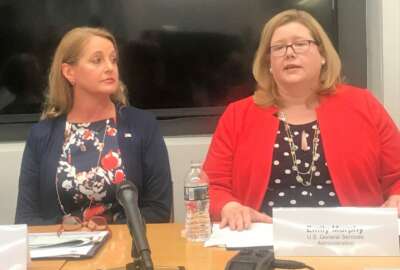
Small-agency CIOs embrace OMB’s push toward more shared services
With OMB poised to have more agencies to make the switch to shared services for back-office functions, chief information officers at smaller agencies say they�...
With the Office of Management and Budget poised to have more agencies to make the switch to shared services for back-office functions, chief information officers at smaller agencies say they’re on board with the plan.
In April, a memo from acting OMB Director Russ Vought identified four agencies to take the lead on shared services in certain disciplines by standing up Quality Services Management Offices (QSMOs).
Under the operating model:
- The General Services Administration would serve as the central hub for human resources and payroll services.
- The Treasury Department’s Bureau of the Fiscal Service would take charge of a QSMO for financial management.
- The Department of Health and Human Services would focus on modernizing the grants management process.
- The Department of Homeland Security would lead the QSMO for cybersecurity shared services.
Maria Roat, CIO at the Small Business Administration, speaking Monday at an American Council for Technology and Industry Advisory Council (ACT-IAC) conference, said SBA’s investment review board gave the go-ahead for the agency to work with HHS on grants management.
“I am on board with that, given where our agency is [and] what we do with grants, because we do issue a lot of grants,” Roat said.
Renee Wynn, the CIO at NASA, said with a greater focus on shared services, agency providers need to “think like a startup.” Instead of just offering a service, like human resources-as-a-service, for example, Wynn said providers need to leverage the data behind those transactions.
”I may want to start to look at my hiring actions: Am I hiring vets? Am I hiring minorities? Where am I hiring them? You are not just giving me the transaction of onboarding someone, you are rich with data that I must have from day one,” Wynn said. “That’s the rethinking, I think, that needs to go into shared services. And we’ve got to push, when I get ready to handshake with another agency, my table stakes will be [that] I need access to my information.”
NASA’s Shared Services Center has evolved over the years to continue to stay relevant to the federal community. Wynn said standardizing processes had laid the foundation for robotic process automation. By automating some of the routine, low-skill tasks, Wynn said employees feel empowered to tackle bigger projects.
“That’s the real benefit of sharing services where you can: As you build a strong community practice and you can think about your future and people being part of it, you can innovate off of it. Great ideas form from it and the people feel supported. And when people feel supported, they thrive,” Wynn said.
SOC-as-a-service moving outside DOJ
Some small agencies have already come close to finalizing shared service agreements.
Bill Kirkendale, CIO of the Court Services and Offender Supervision Agency (CSOSA), said the Justice Department’s administrative arm, the Justice Management Division (JMD), will provide its centralized Security Operations Center (SOC) services to his independent agency within the next few weeks.
The SOC shared services agreement between JMD and CSOSA, he added, has been under development for several years.
“They already had an angle on providing this outside of DOJ and built a business plan” to do so, he said.
Gundeep Ahluwalia, the Labor Department’s CIO, also signaled enthusiasm for HHS providing grants management services for his agency, but also stressed the need to consolidate about 39 case management systems within DOL, as well as a sprawl of grants systems.
“If HHS is going to build that service, I can’t take four or five different organizations within Labor — who are doing grants separately in different processes [and] culturally are very different — and then throw it into HHS and hope that it works. You have to reinvent yourself. It’s about business process reengineering,” Ahluwalia said.
DoL has made progress toward consolidating those case management centers, and greater consolidation, Ahluwalia said, could enable the agency to connect some data points, like what jobs and skills are needed in a particular zip code, with other data sets, like the military occupational specialty (MOS) codes for soon-to-be veterans.
“Imagine if you’re able to connect and say, ‘OK, you’re a helicopter mechanic, and there is an engineering apprenticeship in Boise, Idaho. That’s where your family lives, and you’re going to hit stateside next week. Here are the 50 job opportunities or apprenticeship opportunities in your area.’ That’s the power of data analytics,” Ahluwalia said.
But before reaping more of the benefits of its data, DOL needs to establish data governance principles.
Its component agencies, for example, don’t store data sets like addresses the same way. Regulatory restrictions also limit what Bureau of Labor Statistics’ data can be used for. But Ahluwalia said lawmakers may be willing to broaden the scope of how BLS data can be used, if compelling use cases exist.
“You have to go back and forth with Congress to say, ‘OK, we understand the privacy concerns, but here is the realm of the possible if, within the private privacy concerns, we are able to commingle or do some analysis across these data sets,’” he said.
Copyright © 2024 Federal News Network. All rights reserved. This website is not intended for users located within the European Economic Area.
Jory Heckman is a reporter at Federal News Network covering U.S. Postal Service, IRS, big data and technology issues.
Follow @jheckmanWFED





